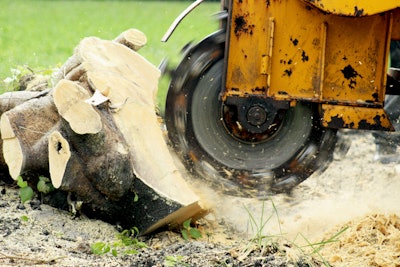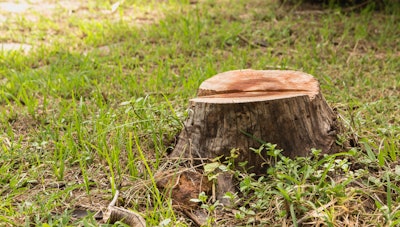
Many clients long to have a flat, well-manicured lawn, but if their yards have pesky stumps in the way, the aesthetic can be thrown off.
Take a look at a few tips tree experts recommend when removing a stump, as well as how to avoid some of the most commonly made mistakes during the process.
Your preferred method
Stump grinding is the name of the game for Todd Burke, owner of Dave’s Tree Services in Egg Harbor, Wisconsin, as it’s one of the most commonly performed services in their area.
While there may be multiple methods for removing stumps, in his experience, Burke says the best way is by using equipment specifically designed for stump removal.
“You can fight with a lot of different methods, but an actual stump grinder is going to do the job best,” says Burke. “Heavy equipment will do the job, but it’s not the answer. You’re going to have a big mess that way.”
For their crews, Burke says they have two different stumpers. A larger one is pulled behind their vehicle and is used on larger projects, and the other is self-propelled and used on smaller projects.
Burke says he’s seen people use chemicals to remove stumps and others that attempted burning the stumps out, but he says he’s personally never seen the best results come from these methods.
“Those are home remedies, I guess you could call it, that I don’t feel work very well,” says Burke. “And of course, you get homeowners that want to do it themselves and go down to the hardware store and rent a small handheld version of a stumper.”
If the stumps are small and are of the softwood variety, Burke says this can be an effective solution for homeowners who prefer to do their own stump removal, but if the stump is a hardwood variety or is larger, it won’t be as effective.
“I hear homeowners say all the time they’ll take care of the stump themselves, and I’ll make the comment, ‘Well, when that doesn’t work for you, feel free to give us a call back, and we’ll take care of it for you,’” says Burke. “Nine times out of 10, those people call us back. The other methods of stump removal just are not effective.”
Before you hit the site
Before starting the process of stump grinding, Burke says ensuring operator safety is paramount. The number one way Burke says someone can get injured while grinding a stump is by not knowing what’s under the ground.
Burke says the first step in this type of project is to get in touch with the local utility department and to call the Diggers Hotline to ensure all underground lines are clearly marked.
“Before we ever grind the stump, we make sure that yard has flags put out or there are marks spraypainted on the ground where there would be any utilities like a water line, electrical line or a gas line,” says Burke. “Whether this stump is properly marked for any underground utilities or not is your number one safety factor.”
When Burke does the locates or e-locates, he requests they mark out 10 feet around any stump that’s getting ground out. Burke adds that it doesn’t cost the customer or contractor anything to get these things marked off.
Burke says you need to also make sure you have properly trained staff working with you on these projects. To ensure this, Burke says they have safety manuals and a safety chart in each of their vehicles, and they perform safety training on all the equipment before getting out in the field.
“You do not want to take another individual who is not used to that machine, just give them a two-second rundown on how it works and have them go and grind stumps,” says Burke. “You want an operator very familiar with the machine.”
Even if everything is carefully marked, Burke recommends always having a plan in place to deal with what might happen if a line is hit.
“There should be safety policies and procedures so all of your stumper operators are aware of what they should do in case of an emergency,” says Burke. “When it comes to a job, no matter what job you’re doing, I don’t think you can be too safe or too prepared.”
 Photo: Shutterstock
Photo: ShutterstockGetting started
Once on the jobsite, Burke says to set up a safety barricade around the stump to keep debris from flying back and hitting operators.
After the barricades are up and the proper personal protective equipment (PPE) is on, he recommends taking a pickaxe and going around the area of the stump to see if anything can be pulled up before grinding begins.
Burke says a popular reason among customers for why a stump needs to be removed is to help the look and layout of the yard. Stumps can get in the way of mowing and lawn maintenance, so removing them and filling in the hole can help restore the space to its former glory.
When grinding a stump, Burke says it’s important to make sure you grind deep enough that the whole mound is ground out, which includes the roots and any dirt that flares up to the stump.
Burke says in many cases, customers want a stump removed so they can use that space for other plants, and sometimes they want to replant a new tree in the area.
If this is the case, Burke recommends not planting a new tree in the exact spot where a stump was removed. Even when the process is done thoroughly and correctly, Burke says there’s always a chance that the stump was not ground deep enough to entirely remove old root remnants that could interfere with a new tree’s development. Instead, he recommends filling the hole in and planting new trees close to the area.
If operators aren’t comfortable grinding the stump located close to a marked line, Burke suggests opting out of grinding the stump with machinery. If that’s the case, Burke says you can take a chainsaw and flush it as close to the ground as you possible so it’s not as unsightly. Or, he says you can hand dig down next to the utility line and use a mechanical grinder if you feel confident you could remove the stump that way.
“Once you know that you are safe at that point to grind, then you can commence stump grinding, but then you be careful that you do not go deeper than what you hand dug,” says Burke. “Stumps can be ground when they’re close to utilities. You just have to use extreme caution.”
Once the project is complete, Burke says it’s best to immediately clear the site of all debris, as it will be much easier to clear while the chippings are light and fresh. Next, make sure the hole is completely cleared out and fill it in with fresh topsoil.
Burke says to then rake over the area and lightly pack it down. Lastly, he says to break up the top of the dirt a bit and sprinkle grass seeds on it to help encourage new growth in the area.











